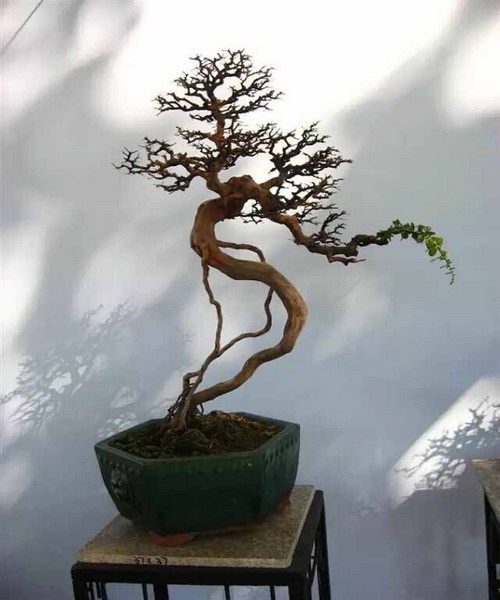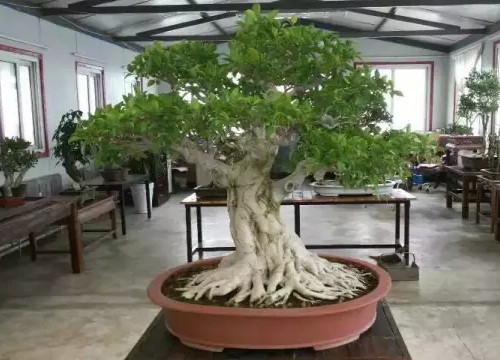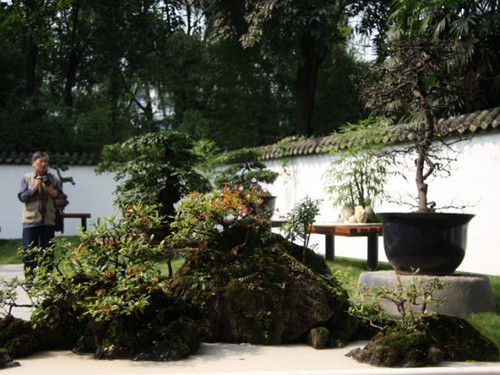Bonsai in Flower Village of Lingnan-- on the Origin and Development of Bonsai Art in Fangcun
Fangcun Flower Land is the birthplace of Lingnan Bonsai. Huadi, formerly known as Huadai, is located on the bank of the Pearl River White Goose Pool in Guangzhou. It has a history of planting flowers for nearly two thousand years. At the end of Qing Dynasty, Kang Youwei once built a villa "Kang House" in Kang Garden of Flower Land, and wrote a lot of poems here, among which there are poems praising "Thousand Years of Flower Dai Still Prosperous" and "Hundred Temples Cultivate Flower Dai House". During the Ming and Qing Dynasties, flower gardens were everywhere, including eight famous flower gardens, mainly producing flowers such as jasmine, jasmine, peony and white peony, and making bonsai of ancient trees for sale in flower market. At the end of the Qing Dynasty and the beginning of the Republic of China, major gardens and flower fields in flower fields prevailed during God's birthday or traditional festivals. Strange flowers and ancient bonsai were placed in the gardens for visitors to watch and evaluate, attracting thousands of tourists. Fangcun Flower Land has the reputation of the first flower town in Lingnan, and the bonsai art is constantly innovating and developing.

At that time, the bonsai, shape was more "zigzag" shape, the main tree has 5 curved positions, each curved position long a branch support, the top of the tree is square. The tree is "Tianluo head" or "Bao Yatou" and so on. There is also a kind of bonsai, with iron wire will tie the trunk into Fu, Lu, Shou and other shapes, or bird and animal shapes. Ancient tree varieties are elm, murraya paniculata mainly. This kind of old-style bonsai, unique primitive style, but stereotyped, lack of aura, and the development of the times does not correspond.
From the 1920s, new changes appeared in the plastic arts of flower bonsai. Some bonsai artists are not satisfied with the dull and old-fashioned shape of the old bonsai. They draw lessons from and absorb the artistic essence of Lingnan Painting School and innovate. Through continuous practice and exploration, they form the original bonsai art style--Lingnan Bonsai Art. Flower land outstanding people, garden artists gathered, Lu Xueming, Kong Taichu, Su Lun, Liang Shen and other pioneering figures, their bonsai works colorful, unique Lingnan style, displayed in the world, called Lingnan bonsai art master.
Lu Xueming, whose ancestral home was Nanzhuang, Nanhai County, moved to the new street of Confucian Forest in the late Qing Dynasty, opened Cuixiang Garden, planted flowers and fruits for his career. Lu Xueming was poor and had only studied private school for one year. He followed his father to plant flowers in Cuixiang Garden. He was carefully taught by his father and gradually fell in love with bonsai skills. At that time, the neighbor had an old bonsai artist who specialized in making some new bonsai with poetic and picturesque feelings and landscape style. Lu Xueming often visited, observed and studied at his home. Influenced by his art, he had certain attainments in bonsai art. In his artistic exploration, Lu Xueming also learned and absorbed the conception and layout of traditional Chinese landscape flower-and-bird painting, figured out the artistic realm of "looking thousands of miles away in a square inch", and applied it to the creation of Lingnan bonsai art. In terms of cultivation techniques, Liu Xueming created skills such as "branch storage and trunk cutting","big floating technique" and "T-shaped grafting method" through continuous practice, so that the modeling of Lingnan bonsai is more imitated by nature, presenting both natural beauty and artistic beauty, originating from nature and higher than nature.
Kong Taichu, born in the early years of the Republic of China, was intelligent since childhood and liked calligraphy and painting. When he was young, he opened "Shengmaotai" tea house in Xiguan, Guangzhou, and operated the tea business. During the War of Resistance Against Japan, he moved to Fangcun Flower Land and became a neighbor with Lu Xueming. Kong Taichu also loved bonsai art. He often went to Cuixiang Garden to watch the bonsai made by Lu Xueming. He gradually became interested in bonsai art. Because of like-minded, there is a common ideal and pursuit for bonsai innovation. Kong Taichu opened up a garden next to his home to plant bonsai, carefully produced and cultivated. Kong Taichu advocated realism, reproduction of nature, hand-copied and painted tree stumps, pasted all doors and windows, day and night to figure out, capture inspiration. Kong and Lu learn from each other, cooperate with each other, and constantly innovate on bonsai art. After many years of artistic practice, Kong Taichu made a variety of bonsai art models, including weeping willow type, kapok type, banyan type, attached stone type, cliff type, lying stem type and other forms, forming a vigorous unique artistic style, creating a new milestone in Lingnan bonsai art.
Su Lun, whose ancestral home was Yagang Ancient Material Village in the suburbs of Guangzhou, moved to flower land during Guangxu years and opened Fulin Garden to plant flowers and trees. Su Lun's father was Su Woonong, a famous Lingnan painter. When Su Lun was in his teens, he was carefully educated by his father. While learning painting, he was engaged in planting flowers and making bonsai. He applied the concept and layout of traditional Chinese landscape flower and bird painting to bonsai art. His bonsai art works are full of poetic and picturesque feelings, like frames of "three-dimensional paintings" and poems without words, which open up the pattern of Lingnan bonsai art and are deeply loved by people.
Liang Shen, whose ancestral home is Chen Village, Shunde, Guangdong Province, moved to flower land at the age of 19, and later went to Cuixiang Garden to learn art, engaged in planting flowers and making bonsai. He was studious and hardworking. In order to select all kinds of bonsai tree species, he went to Guangdong alone to dig stumps in the mountains, went through hardships, did not fear dangers, dug back all kinds of stumps, and then carefully cultivated and pruned. After many years of artistic processing, in Cuixiang Garden, there are dozens of different styles of bonsai. There are vigorous and upright elm trees, Jiulixiang, Podocarpus, but also clear and beautiful sky stars, mountain oranges, crape myrtle, etc., colorful, let people dizzying, Lingnan bonsai art garden is the most beautiful exotic flowers.
In the early days of the founding of New China, Guangzhou City strongly supported and developed the production of flowers and potted plants. Flower gardens and flower farms are everywhere, becoming the production base of flowers and bonsai in Guangzhou City. At the beginning of 1958, Tao Zhu, secretary of the Guangdong Provincial Party Committee, visited Fangcun Huadi Zuiguan Garden and Dongda Garden to understand the production of flowers and bonsai, and instructed to further develop flower planting industry and vigorously accelerate the development and innovation of Lingnan bonsai. In August 1958, Guangzhou City decided to open Guangzhou City Horticulture School in Huadi Luoshi Ancestral Temple to train flower horticulture technical talents. During the school period, the school invited bonsai artists Lu Xueming, Liang Shen, Su Lun and others to give lectures and teach the methods and skills of making bonsai. In the autumn of 1959, He Xiangning, Vice Chairman of the Standing Committee of the National People's Congress, who was over 80 years old, visited Guangdong and visited the flower field and east to understand the flower production situation. She praised Lingnan bonsai and hoped that this art brand would be based in Guangzhou and go to the world. In June 1960, Chairman Zhu De went to Fangcun Drunken View Garden to visit and admire flowers after his official work in Guangzhou. He stood in front of Liang Shen's bonsai and praised repeatedly: "Lingnan bonsai, can be called a unique." In 1964, Premier Zhou Enlai selected four fine pots of Lingnan bonsai in Guangzhou (masterpieces of Lu Xueming, Kong Taichu and Liang Shen respectively) and presented them to Ethiopian Emperor Haile Selassie. Later, the emperor placed bonsai in the palace, which was praised by Egyptian officials.
During the Cultural Revolution, flowers and potted plants were regarded as "sealed, funded and repaired" things, and production was restricted. Each farmer was allowed to plant only three potted plants. Many flower growers are forced to cut down bonsai that have been carefully crafted for years. Many flower farms in Fangcun were ordered to close and plant vegetables and other crops instead. The floriculture industry has been severely damaged. In 1983, Fangcun Flower Land was invited to participate in the Hong Kong International Flower Bonsai Exhibition. The five potted plants presented by Lu Xueming were deeply loved by Hong Kong citizens and all were subscribed. One potted elm potted plant was sold for HK $50,000. In October 1986, Queen Elizabeth II visited Guangdong. Governor Ye Xuanping, on behalf of the people of Guangdong, presented the Queen with a precious gift-Jiulixiang Lingnan Art Bonsai. This is the work of Su Lun, the master of flower bonsai art. It has been cultivated for more than 60 years. The trunk is vigorous and vigorous, colorful and fragrant. It is a perfect art masterpiece. Jiulixiang is of the same age as the Queen of England and has special significance. It is deeply loved by the Queen of England.
In 1989, Lu Xueming was awarded the title of "Master of Chinese Bonsai Art" by the Ministry of Construction. This is the highest honor given to Lu Xueming. He has been pursuing art for 50 years and has finally reached the peak of bonsai art. The master of art deserves it! This is also the highest evaluation given by the state to Lingnan bonsai art. After the 1980s, a large number of flower bonsai artists emerged, they inherited the tradition and innovation, and continued to develop. The representatives of the new generation of bonsai artists include Lu Zhiwei, Lu Zhiquan, Tan Binghuang, Li Yuankai, Li Hongbin, Guo Rupei, Yu Zili, Chen Mingfu, Su Chang, Yu Zhengbiao, Chen Weifu, Liang Weijia and Xie Bingkun. These come from the bonsai expert of area of Fang Cun flower ground, have a lot of is countrywide, province, city bonsai association member. Their bonsai art works are well known in Hong Kong and Southeast Asia.
Lu Zhiwei is Lu Xueming's eldest son and was a member of the CPPCC in Guangzhou City and District. He has been taught by his father since childhood, and he is good at learning and brave in practice. For more than 30 years, he has constantly innovated Lingnan bonsai art, explored dozens of new shapes and grafting methods of bonsai, and pushed Lingnan bonsai art to a higher artistic level. Lu Zhiwei also constantly summed up the experience of planting and wrote a large number of theoretical articles published in domestic and foreign newspapers. His bonsai works have won many awards at the National Bonsai Exhibition. Among them, his Fujian tea bonsai "Tanyu" won the gold medal at the first International Bonsai Exhibition held in Beijing in 1991; his Acacia bonsai "Snow Dry Lingxiao" won the special prize at the Cross-Strait Bonsai Exhibition held in Beijing in 1992; and his Fujian tea bonsai "Green Bridge" won the gold medal at the Hong Kong Cup China Bonsai Exhibition held in Guilin in 1997. In 2004, Lu Zhiwei was awarded the title of "Master of Chinese Bonsai Art" by the Department of Urban Construction of the Ministry of Housing and Urban-Rural Development. He also served as Vice President of China Bonsai Artists Association. Lu Zhiwei not only set up a bonsai garden in Fangcun, but also set up a bonsai farm production base in Huadu City, mainly to produce miniature bonsai, and the products are exported to Western Europe and North America.
Fangcun flower land is therefore known as "Lingnan first flower town" and "Lingnan bonsai birthplace." In the early 1960s, Marshal Chen Yi wrote a moving poem entitled "Fragrance of Plants and Plants in Fangcun Flower Field", praising the scene of flowers and plants competing with each other. Nowadays, the flower field keeps pace with the times, making Lingnan bonsai art famous all over the world and more dazzling and brilliant.
(The author is East of Liwan District! Retired teacher of middle school, writer of literature and history materials in Liwan District)
Time: 2019-06-04 Click:
- Prev

Maintenance and management skills of Lingnan banyan bonsai
Lingnan banyan bonsai can grow in three or four seasons, but in this process, it is easy to grow fast, obese and tender, which leads to a decline in the age quality of many molded works. Affected by the cold climate, our bark grows slowly, so it has the characteristics of old skin, tight skin and experienced piles.
- Next

Sichuan style bonsai reflects the elegant urban temperament of Chengdu.
Bonsai is a bright spot in Chengdu's gardens and museums. As a characteristic intangible cultural heritage of Chengdu, Sichuan style bonsai is one of the four major schools of Chinese traditional bonsai. From the Eastern Han Dynasty, bonsai artists in Shu began to explore how to condense the wonders of landscape and nature into a small basin. To the five dynasties
Related
- Fuxing push coffee new agricultural production and marketing class: lack of small-scale processing plants
- Jujube rice field leisure farm deep ploughing Yilan for five years to create a space for organic food and play
- Nongyu Farm-A trial of organic papaya for brave women with advanced technology
- Four points for attention in the prevention and control of diseases and insect pests of edible fungi
- How to add nutrient solution to Edible Fungi
- Is there any good way to control edible fungus mites?
- Open Inoculation Technology of Edible Fungi
- Is there any clever way to use fertilizer for edible fungus in winter?
- What agents are used to kill the pathogens of edible fungi in the mushroom shed?
- Rapid drying of Edible Fungi

